This hands-on activity engages students in exploring how invasive organisms can easily and effectively disperse from one area to another. By visiting a series of Challenge Stations and experimenting with different materials, students take part in competitions to see if they can overcome being a vector of spread and prevent the spread of invasive species.
This activity is based upon Vectors of Spread by Sue Staniforth, originally published with many other hands-on activities in the Aquatic Invaders! An Activity Package for Teachers and Youth Leaders.
Learning Objectives
By participating in this activity students will:
- Understand some of the main characteristics that make a species invasive, including high reproductive rates and effective methods of spread.
- Participate in hands-on challenges to investigate several vectors of spread/ human activities that contribute to the spread of invasive species.
- Learn how seeds, plant parts, and insects may be transported on people, pets, firewood, boats, and vehicles.
- Be able to explain why people should not release any animals, plants, or aquarium water into waterways.
- Understand and apply strategies to prevent the spread of invasive species, such as Clean Drain Dry, Play Clean Go, and Buy Local Burn Local
Inquiry Questions
- How do people’s actions (or inactions) contribute to the spread of invasive species?
- How do invasive species harm other organisms or ecosystems?
- What are some impacts of invasive species in my region?
- What can be done in my region to prevent the spread of invasive species?
BC Curriculum Links
Core Competency- Personal and Social
Social Awareness and Responsibility: Contributing to Community and Caring for the Environment
Science Big Ideas
- Living things have features and behaviours that help them to survive in their environment (Grade 1)
- Living things have life cycles that are adapted to their environment (Grade 2)
- Living things are diverse, can be grouped, and interact in their ecosystems (Grade 3)
- All living things sense and respond to their environment (Grade 4).
- Multicellular organisms have organ systems that enable them to survive and interact within their environment (Grade 5)
- Multicellular organisms rely on internal systems to survive, reproduce, and interact with their environment (Grade 6)
- Evolution by natural selection provides an explanation for the diversity and survival of living things (Grade 7)
Science Curricular Competencies
Numerous Science Curricular Competencies are addressed for all grades, for example:
- Demonstrate curiosity about a scientific topic or problem of personal interest
- Observe, measure, and record data, using appropriate tools
- Explore and pose questions that lead to investigations
- Experience and interpret the local environment
- Demonstrate an understanding and appreciation of evidence
- Express and reflect on personal, shared or others’ experience of place
- Make observations in familiar or unfamiliar contexts
- Transfer and apply learning to new situations
Materials
See the Procedures Section for details on the materials needed and the setup for each Challenge Station. Additional materials needed for all stations include:
- Timer / Stopwatch
- Camera for ‘Inspectors’ to record results of Challenge (or paper, clipboard, and writing utensil, if recording observations).
- Photos of invasive species relevant to your region (See Additional Resources section)
Documents to Download
- Behaviour Change Logos (English) – to print as signs for Challenge Stations
- Behaviour Change Logos (French) – to print as signs for Challenge Stations
- Challenge Station Instructions for Students – to print and place at Stations
Background
Invasive species are introduced, non-native organisms that negatively impact the environment, the economy and society. For a general background on invasive species and their impacts, read Background on Invasive Species for Educators.
Invasive species have many adaptations that allow them to spread and take over, including rapid and prolific reproduction, fast growth rates, and efficient means to disperse from one place to another. Invasive species travel further with the help of water, wind, people, pets, vehicles, soil, gravel, and equipment. Many of these invaders are spread by humans, through industry such as logging and mining, recreational activities like boating and camping, and gardening and horticulture. Whether intentional or by accident, human activities often aid in the spread of invasive species.
In other words, people and our activities serve as vectors of spread, aiding invasive organisms to spread and take over new places. A vector is any living or non-living thing that moves an invasive species on purpose or by accident. The positive spin on people being responsible for the spread of invasive species is that there are simple actions that we can all do to prevent being a vector of spread.
Terrestrial Invasive Species—PlayCleanGo
Terrestrial plants have a wide variety of adaptations for dispersing to new places. Many invasive plants reproduce not only by seeds, but also by above ground runners, below ground rhizomes, or even plant fragments that can take root. Baby’s breath, a plant sought after by florists for flower arrangements, can produce more than 10,000 seeds, and these are distributed over long distances when the whole stalk breaks off at ground level and rolls like a tumbleweed! Light fluffy seeds, like those of thistles, Spotted and Diffuse knapweed, and Yellow salsify move with the wind for long distances. Buoyant, flattened seeds, like those of Yellow flag iris, Butterfly bush or Purple loosestrife flutter a short distance and then may float down a river or across a lake. Burred seeds, like those of Burdock and Hound’s tongue have tiny hooks that will stick to skin, fur, feathers and clothing. Once they are attached, they can cling for long distances before they eventually fall to the ground.
Human activities and our gear are a vector of spread for terrestrial plants. Sticky seeds can cling for long distances before we bring them to a new place where they eventually fall to the ground. Other invasive plants or even insects can hitch a ride by sticking to the mud in our boots or on muddy tires of bikes, ATVs and other vehicles. By practicing PlayCleanGo – inspecting and removing plant parts, seeds, and insects from our clothing, vehicles, and gear- we can ensure that we arrive and leave our favourite outdoor sites ‘clean’ without accidentally bringing along any hidden and damaging ‘hitchhikers’. It’s especially important to inspect and clean vehicles, clothing and equipment before leaving an area that is known to be infested with an invasive species.
Aquatic Invasive Species—Clean Drain Dry and Don’t Let it Loose
Aquatic invasive species are incredibly difficult to manage because they move easily within a water body, such as a lake or river, and will eventually occupy the suitable habitat in that water body. Aquatic plants and animals are sometimes able to survive out of water for short periods of time. This adaptation allows them to hitchhike with people on our watercraft, fishing gear, or other equipment and spread to another body of water the next time we take our boats or gear out. Parrot’s feather, a popular aquatic garden plant that has spread throughout the Fraser Valley, can cling to boats and fishing gear; even a small plant fragment can grow into an entire new plant and infest a water body. Zebra and Quagga mussels can attach to boat hulls and survive out of the water for up to 30 days! Their microscopic eggs and larvae can easily be transported from lake to lake in any water on a boat, including ballast tanks and motors.
We can help to protect our beautiful lakes and other bodies of water from the spread of aquatic invasive species by practicing Clean Drain Dry: Clean off all animals, plants, and mud from your boat and gear; Drain all water from your boat and gear onto land; and completely Dry all parts of your boat and gear.
Another way that aquatic invasive species spread is by people who let loose fish or other aquatic animals or aquarium waters into the wild. Goldfish, Red-eared slider turtle, and Eurasian watermilfoil, are all examples of animals and plants that started out in tanks or home garden ponds and now cause serious problems for BC’s biodiversity and aquatic ecosystems. Don’t Let it Loose! It’s important to never release your plants and animals into the wild or dump aquariums or water garden debris into rivers, streams, lakes, or storm sewers, where they can establish, thrive, and move to other waterbodies. By practicing Don’t Let it Loose and Clean Drain Dry we can do our part to help protect aquatic ecosystems.
Forest Pests—Buy Local Burn Local
Firewood is a vector for the spread of invasive wood-infesting insects. Insect adults may (or may not) be visible on firewood, but their eggs and larvae can easily be hidden inside of wood. Invasive insects that could decimate our forests if introduced include Spongy moth, Asian longhorned beetle, Emerald ash borer, and Spotted lanternfly. As of 2022, the only insect of these examples that is found in BC is the Spongy moth, but it doesn’t have any permanently established populations due to regular eradication efforts. The other insect species named are spreading rapidly in North America and could arrive in BC if we don’t take preventative efforts. New infestations of harmful insects and diseases are often first found in campgrounds and parks. We can help to protect these special places by ensuring that we only buy or burn local firewood. Moving firewood, to or from a campground or cabin, can spread invasive species and diseases that can destroy our forests and harm our air and water. Protect our forests by keeping firewood local. Buy Local Burn Local.
Procedure
- Read through each of the 4 Challenge Stations and prepare the set-up. Notes: Stations are most suited to an outdoor area like the school playground or field, where it’s ok to get muddy or wet, and a water supply and a sink or drain area is needed for Challenge Station #1.
- Gather Materials (See the list of what is needed in the description of each Challenge Station, below) and include at each station the relevant printout of the Logos for Behaviour Change and Instructions for Students, available in the Documents to Download section above.
- Review Background Information and introduce the topic and example species to students.
- Divide the class into small teams to compete at each of the Challenge Stations. NOTE: Challenges can be done simultaneously by 2 teams (increased excitement) if you have enough materials to duplicate each station. Alternatively, each team will individually circulate through the stations and results will be recorded by collecting data (e.g. by taking photographs) and one person on each team will be designated an Inspector, who will keep track of Challenge results. Review and/or demonstrate the procedure for all stations together as a group before starting the Challenges.
- Follow the additional procedures described for each Challenge Station.
- After rotating through all stations, debrief results. What Challenge was the most difficult? The easiest? What did you learn about how invasive species can spread? How will your behaviour in the outdoors change after participating in this activity?
Challenge Station 1: Clean Drain Dry and Aquatic Hitchhikers
Here students place toy boats in tubs of water to investigate how fragments of aquatic plants or aquatic animals can attach to watercraft and spread to another boy of water. Students are challenged on how well they can Clean, Drain, and Dry their watercraft.
Materials
- 2 large bins filled with water – labelled ‘Lake’ 1, ‘Lake’ 2 (choose local waterbody names)
- Clean Drain Dry (and Don’t Let it Loose) signs and Student Instruction Sheet
- Additional water source will be needed to drain/refill one of the bins at the start of each round.
- 3-5 miniature ‘watercrafts’ such as toy boats, or you can use any floating material such as plastic bottles, trays, containers and lids (like a paddle board).
- Dried herb, such as basil, sage, or dill weed (Representing aquatic invasive plants or animals). Sprinkle 1-2 spoonfuls into only 1 of the ‘lakes’ (water bins)
- 3-5 tools for cleaning watercraft, such as spray bottles, brushes (old toothbrushes), sponges, cloths.


Procedure
- Set the scene: Students are recreating at a local lake with boats, paddleboards, floaties, fishing gear, etc. and will use these watercraft and equipment in another lake the next day. Lake 1 has aquatic invasive species (for examples see Background info and at Identify – Invasive Species ). The watercraft and gear must be completely free of invasive species (clean, drained, and dried) before leaving Lake 1. The Invasive Species Inspector or Conservation Officer will be on site to inspect.
- Set timer for 4 minutes.
- Have team play with watercraft in bin / Lake 1 covered with floating material, followed by a good Cleaning, Draining, and Drying of each watercraft until team believes boats are free of invasive aquatic hitchhikers– within the 4-minute time limit.
- Have the Inspector ask that each watercraft be individually placed in bin/Lake 2 so everyone can see if they passed the test to stop the spread. Record results by counting the number of herbs transferred to Lake 2 or by taking a photo.
- Clean up Lake 2 to prepare for the next team. Add more herbs to Lake 1.
Challenge Station #2: Play Clean Go and Seeds in our Treads
At this station, students use toy vehicles and boots to illustrate how people can accidentally transport invasive species long distances in the treads of their shoes/boots, horse and pet feet, and wheels of cars, bikes, ATVs and other vehicles or gear. Students are challenged to ‘Play’ in soil loaded with seeds, and then ‘Clean’ the boots and wheels, before they can ‘Go’ to the next recreation site without transporting any invasive plants.
Materials:
- Play Clean Go sign and Student Instruction Sheet (see Documents to Download)
- Potting soil moistened with water (use a spray bottle) or create a muddy area about 1 square meter
- 1-2 cups of spice seeds such as fennel, cumin, or sesame seeds that can be easily seen in mud. Spread the seeds on top of mud.
- 2-3 sandbox type toy trucks or anything with wheels
- Large rubber boots for students to easily slip on
- ~ 5 Brushes for cleaning wheels and boots – toothbrushes or dish sink brushes work well. PlayCleanGo Boot Brushes available for sale from ISCBC (see Merchandise section of the Store).
- Optional: Long piece of cloth (such as an old bedsheet) to walk/drive toy trucks on top of to view how seeds can disperse to new areas.
Procedure:
- Set the scene: Students are working with trucks along a muddy road and walking trails. It is the end of the day, but they can’t Go until their wheels and boots are all clean. Give examples of local invasive plants that have adapted to have large number of seeds (see Background info and at Identify – Invasive Species ). The Invasive Species Inspector or Conservation Officer will be on site to inspect.
- Set timer for 4 minutes.
- Have team play with toy trucks and walk boots through mud/seed patch followed by a good cleaning with brushes until team believes they are free of ‘invasive terrestrial hitchhikers” – within the 4-minute time limit.
- Have the Inspector look at each wheel and boot tread for signs of seeds to see if they passed the test to Stop the Spread. An option is to have a clean cloth or towel to “drive’ and walk on. Record results by counting remaining seeds.
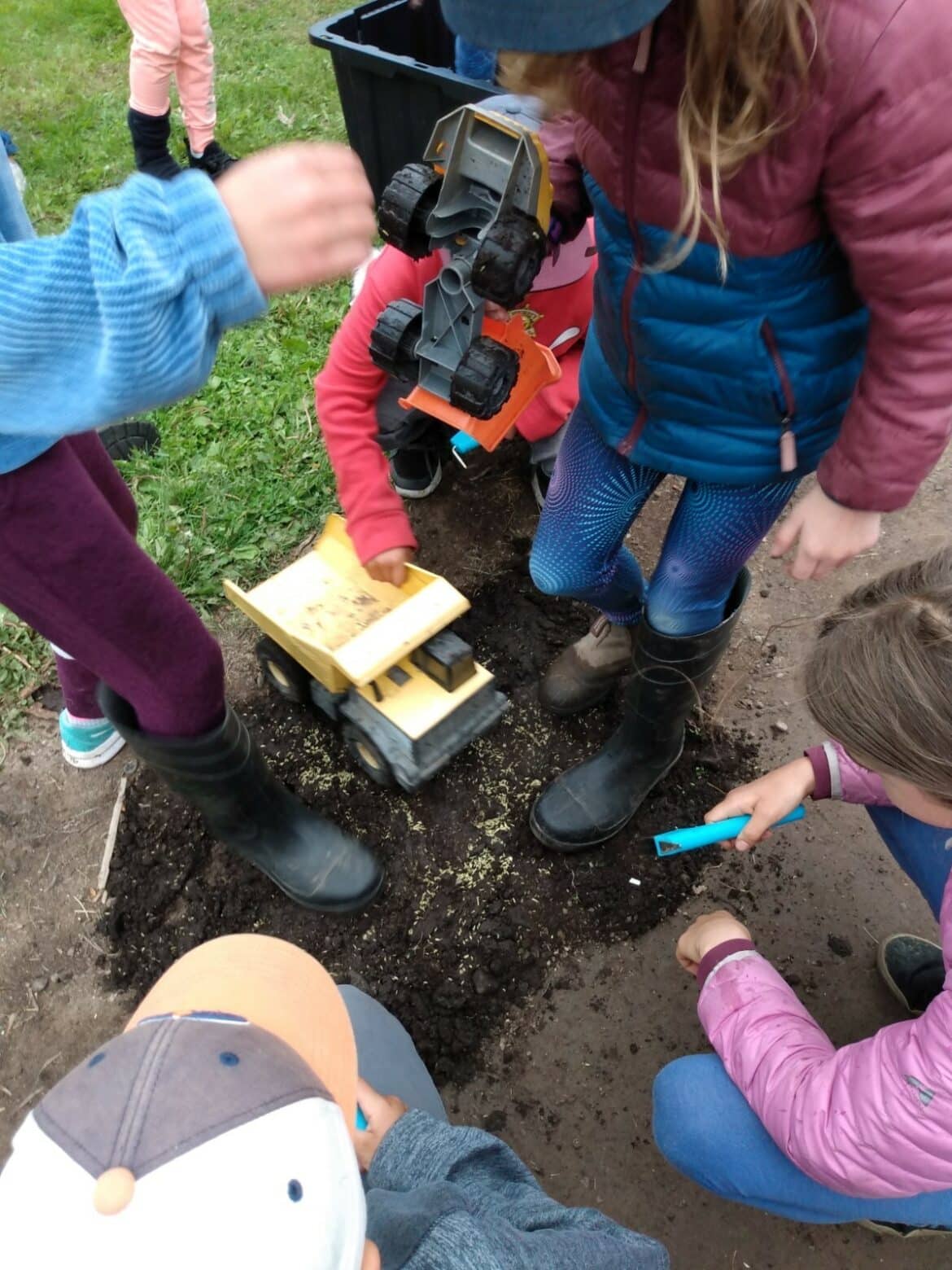
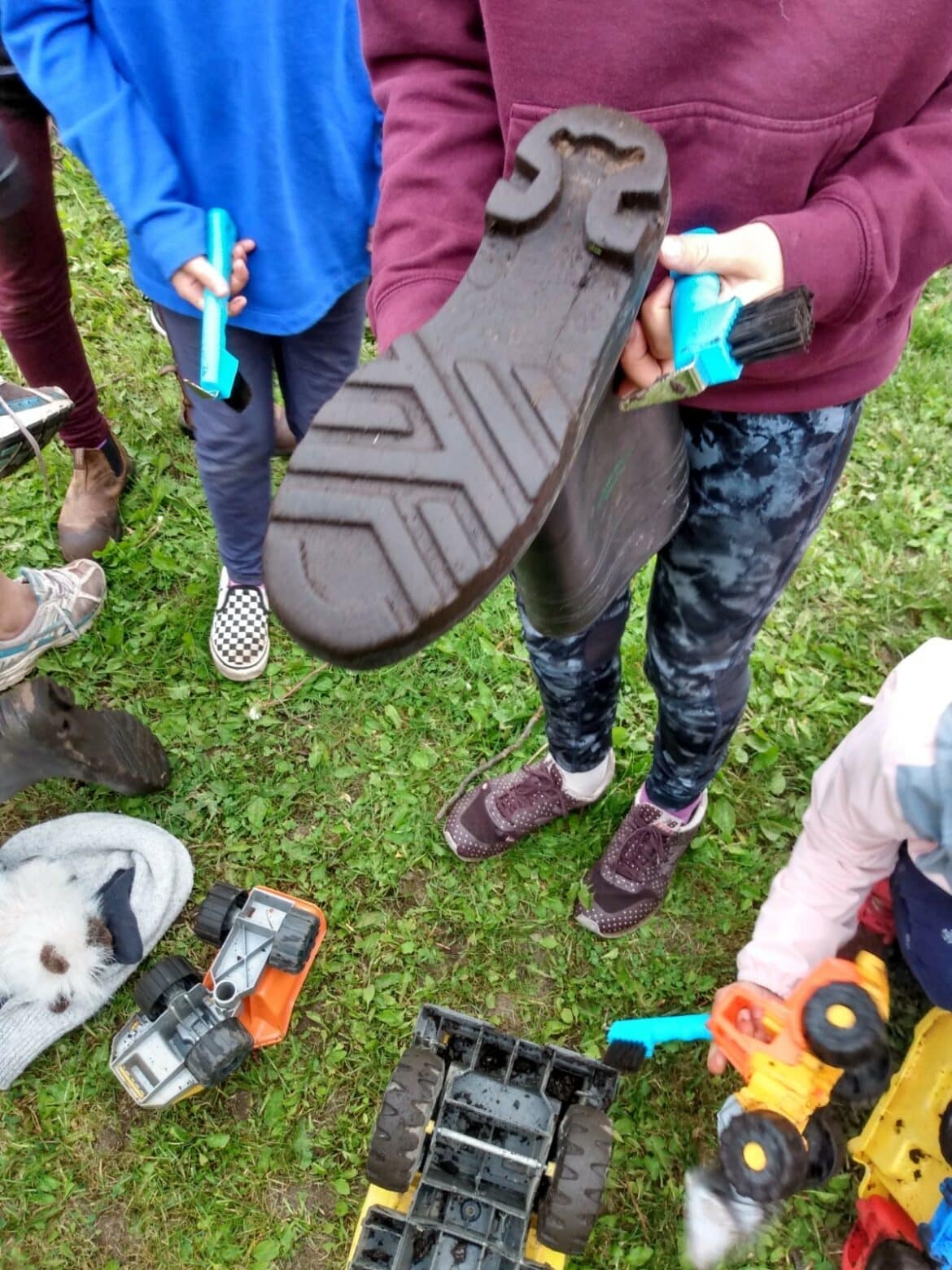
Challenge Station #3: Play Clean Go and Seeds that Stick
Most of us have had the experience of going for a hike and noticing later that our socks, bootlaces, pant legs, and maybe even our dog are covered in seed fluff or burrs. Many invasive plants have excellent adaptations to allow countless number of their seeds to not only fly in the wind, but to also hook on to fur and clothing. At this station, students use socks and stuffies to illustrate how people and pets can be a vector of spread of invasive plant seeds. Students are challenged to ‘Play’ in a bin of mock sticky seeds and then ‘Clean’ the socks and pets, before they can ‘Go’ to the next location, knowing that they have stop the spread of invasive plants.
Materials:
- PlayCleanGo sign and Student Instruction Sheet
- Bin large enough to step into
- 1-2 cups of dandelion seeds / small pieces of Velcro
- 2 pairs of oversized socks – wool / fleece
- 2 stuff animals (optional to include leashes)
- ~ 5 Brushes for cleaning socks and stuffies – toothbrushes or dish sink brushes work well. PlayCleanGo Boot Brushes available for sale from ISCBC (see Merchandise section of the Store).
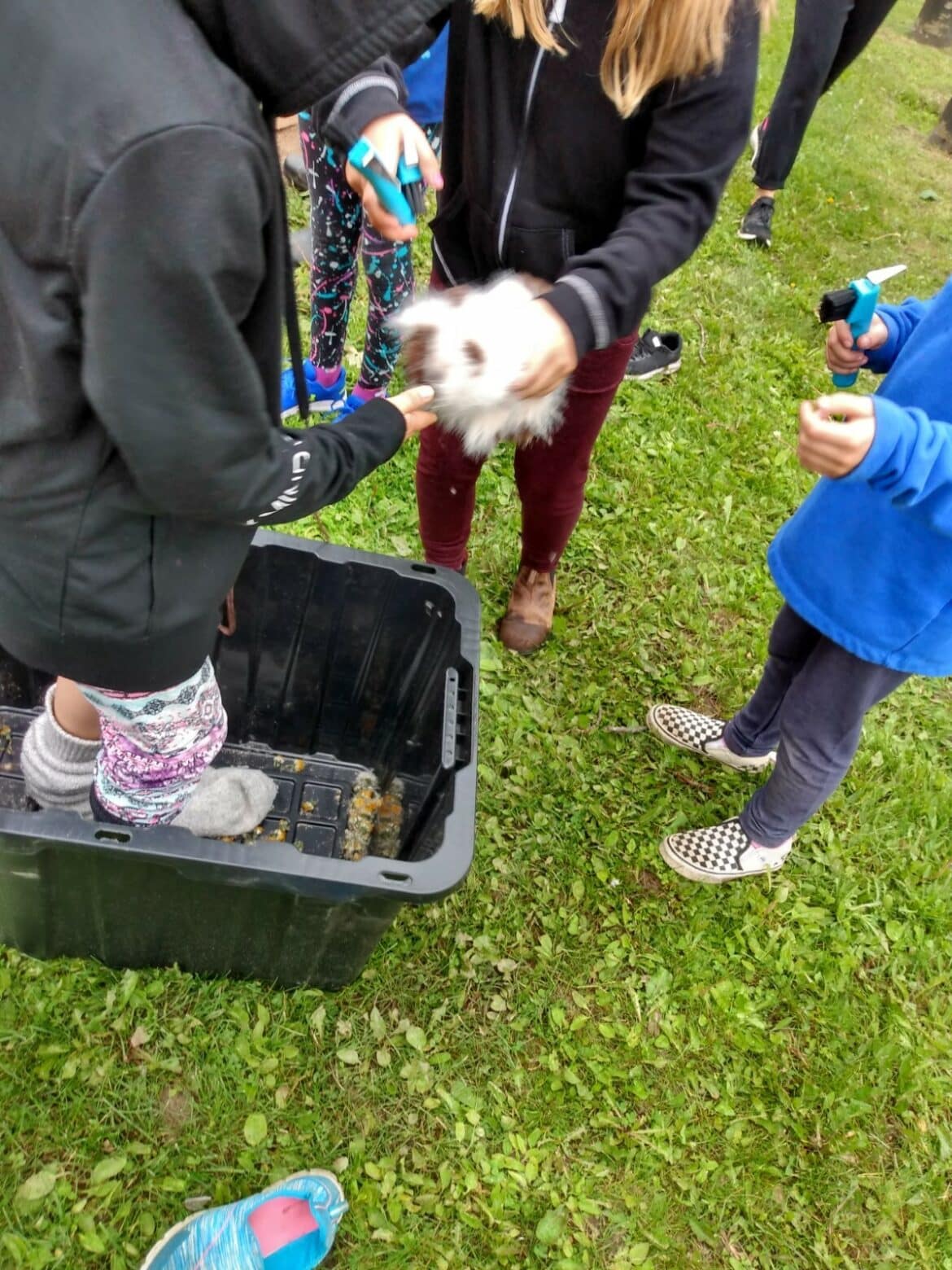
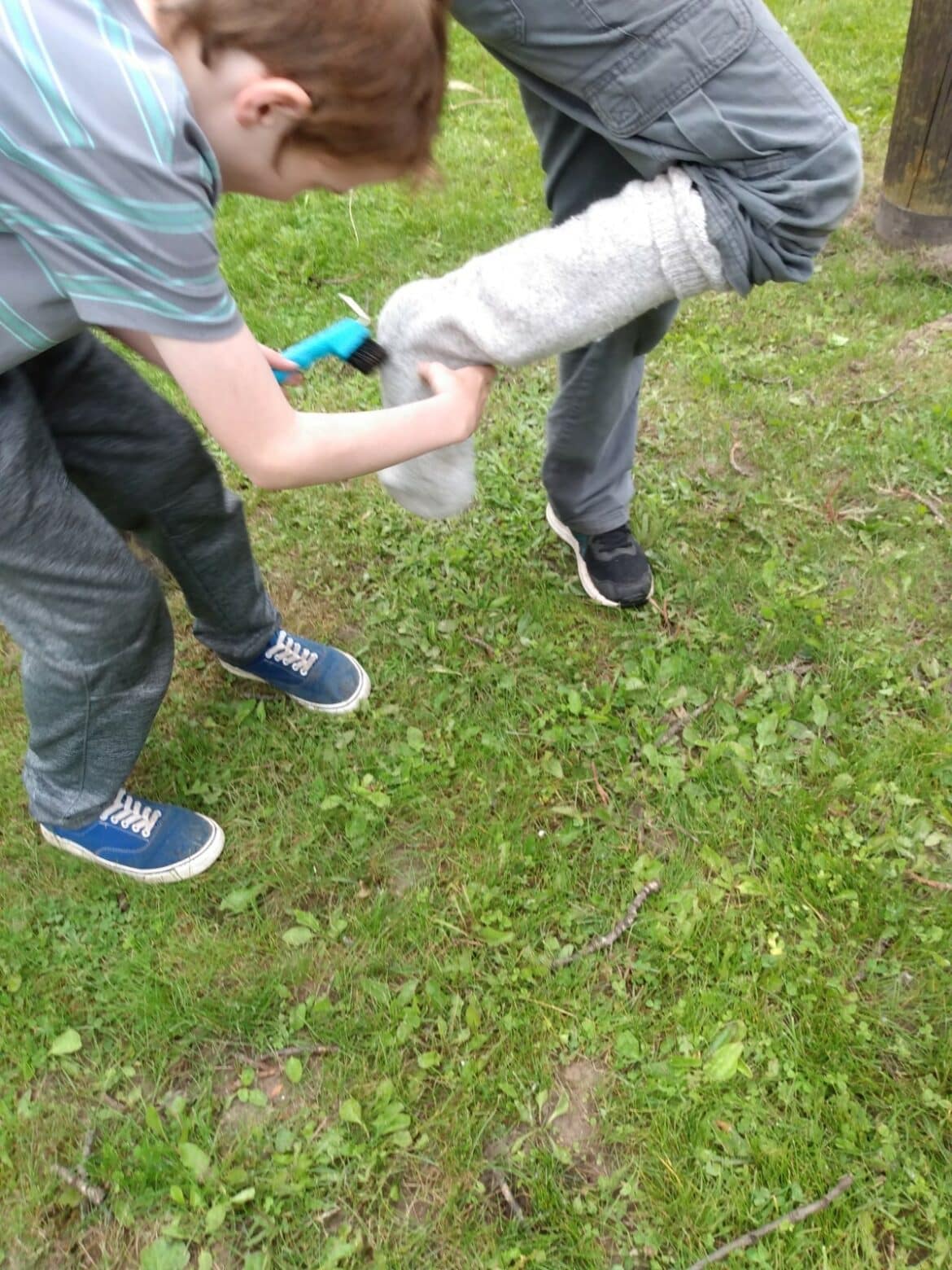
Procedure:
- Set the scene: Students are taking a walk by a local field with their pet to Play. They need to Clean all the sticky seeds from their clothing and pet before they can Go home. Give examples of local invasive plants that have sticky seeds (see Background info and at Identify – Invasive Species ). The Invasive Species Inspector or Conservation Officer will be on site to inspect.
- Set timer for 4 minutes.
- Have team put on socks and walk through the bin / field of sticky seeds and have stuffies play in bin followed by a good cleaning with brushes until team believes they are free of ‘invasive terrestrial hitchhikers’ – within the 4-minute time limit.
- Have the Inspector look at socks and stuffies for signs of seeds to see if they passed the test to Stop the Spread. Record results by counting remaining seeds.
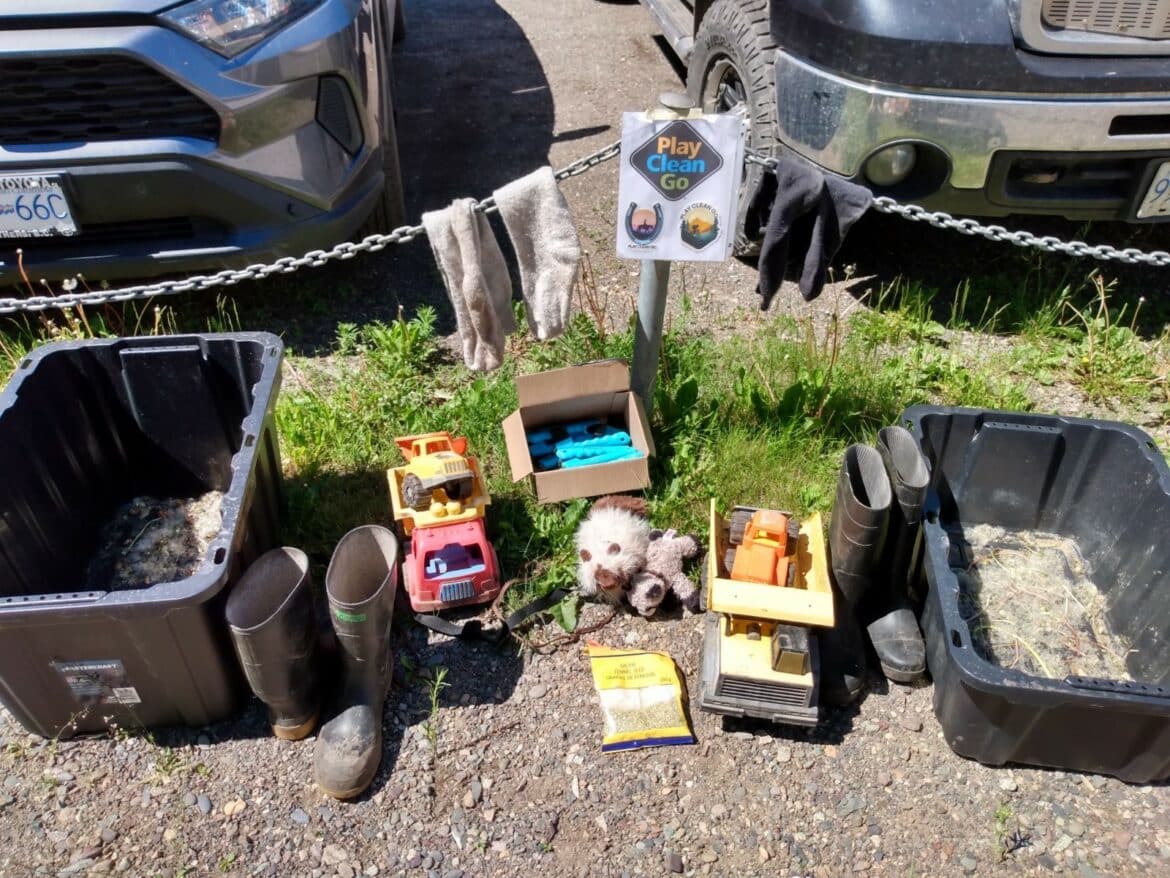
Challenge Station #4: Buy Local Burn Local – Who Hides in Our Firewood.
Students are challenged to find and remove mock insect eggs and larvae from logs or pieces of firewood. This will demonstrate the potential for firewood to be a vector of spread of invasive insects that can decimate forests. Invasive insects that live on or inside wood can be tiny (especially eggs!) and can unknowingly be transported in firewood to a park or campsite, where they can establish breeding populations and cause great damage to forests. Although we wouldn’t normally inspect and remove insects from our firewood, we can ensure that we don’t accidentally transport hidden pests by only buying and burning local firewood.
Materials:
- Buy Local Burn Local Sign and Student Instruction Sheet (Documents to Download)
- 3-5 large pieces of firewood or logs that have bark, crevices or holes (taken locally- Don’t move firewood!).
- Grains of uncooked rice or small beads to represent invasive insects at various stages of their life cycles.
- 3-5 Tweezers, toothpicks, or other tools to extract ‘insects’ from wood
- Collecting containers or egg cartons
- Tarp or blanket to put everything on
- Hand lenses (optional)
Procedure:
- For the first team at this station: Teacher/an adult will hide many ‘insects’ in the nooks and crannies, crevices, and holes in the logs.
- Set the scene: You are going on a long camping road trip to parks in the forest far from home. You have lots of firewood at home. Should you bring it with you? Take a closer look to see who might be living in your firewood. Give examples of invasive insects that infest wood (see Background info and at Identify – Invasive Species ). The Invasive Species Inspector or Conservation Officer will be at your campsite to inspect. (Note: You learned to Buy Local Burn Local and not move firewood. You will not be able to see or remove insect pests from firewood to make it safe to transport!)
- Set timer for 4 minutes.
- Have team look closely at the logs to find as many hidden ‘insects’ as possibly within the 4-minute time period. Use tweezers to remove them and put them into collection containers.
- Have the Inspector look at the logs for any remaining hidden ‘insects’ to see if they passed the test to Stop the Spread. Record results by counting remaining grains of rice/beads. Inspects can also count how many ‘insects’ were discovered and collected in the collection containers.
- Put more beads/rice into the logs to set up for the next group.
Additional Class Demonstrations (Optional)
Here are two additional stations or whole group demonstrations to explore some other ways that invasive species can spread. These can be useful to share before or after participating in the Challenges, when discussing the different adaptations that organisms -and invasive species in particular- have to disperse.
Pond Jumpers
In this station egg cartons are used to represent watersheds and coloured water is used to illustrate how species can spread within a watershed, from lake to lake.
A watershed is an area of land where all the water that runs through it drains into the same place divided by mountains. Two lakes that are very close to each other may drain into completely different watersheds. Although they might seem like similar habitats, they may be completely different communities. All of the water in all of the different water bodies within a watershed is connected. Aquatic organisms do not travel between watersheds naturally; however, people sometimes move organisms from one lake or river to another. Ask students how this might happen (e.g. live fish bait being dumped into lakes; unwanted aquarium pets being released into ponds; eggs and larvae of aquatic animals being transported in boat bilge water between lakes). If organisms that are moved to new watersheds happen to be invasive species, they have an opportunity to invade a whole new watershed, not just a single body of water. Aquarium water should be poured down an indoor drain or poured out on the ground where it will dry out and won’t reach a stream. There may be invasive algae or eggs and larvae of non-native animals that you don’t want to release into a new watershed.
Procedure:
- Fill 2 plastic or styrofoam egg cartons with plain water. If doing indoors, put all materials inside a large bin or on a rimmed cookie sheet/other material to catch spilled water. A towel will also be handy!
- Put one colour (e.g. blue) of food colouring into one of the egg cups in one of the cartons, to represent a native species.
- Put some water in a measuring cup, and add a different colour of food colouring (e.g. red) to represent an invasive species, such as Yellow perch or Yellow floating heart.
- Pour the “invasive species” water slowly into the egg cup with the ‘native species’ and observe what happens. Continue pouring slowly: when the water level reaches the tops of the egg cups, observe that the water in the cup that had a few drops of food colouring changes colour and moves from cup to cup throughout the watershed.
- Now use a spoon to scoop some of the water from the egg carton that is infested with the invasive species and put it into the second egg carton. This would be like transferring the invasive species from one watershed to another.
- Discuss what this transfer would mean in a real watershed. (Once a species is introduced to one body of water, it can travel through water systems to other water bodies).
- Pour from your measuring cup into the newly infested watershed. This represents the invading animal or plant reproducing and is able to spread throughout the new watershed.
Stowaways – Edible Seeds
This demonstration will illustrate how the seeds inside a fruit can survive the digestion process; this is an adaptation that some plants have. Some plants spread their seeds by wind, water, or by hitchhiking on fur or clothing. Other plants encase their seeds in nutritious and tasty fruits to attract animals like birds and mammals. Note that some fruits that are poisonous to people are delicious to birds or other animals! Many fruits are not from invasive species- like blueberry, apple, and salmonberry. But other fruits are from invasive plants, such as Himalayan blackberry and English ivy. Once the animal eats the fruit, the seeds can survive digestion and be deposited into new places, where they will germinate, grow and spread in a location far from the parent plant. To explore how seeds can survive digestion and stomach acids you can try the following:
- Put a few blackberries or raspberries into a small plastic bag.
- Add a little bit of cola beverage (1/4 cup) to represent digestive juices.
- Zip up the bag, making sure it is sealed.
- Press and mush the berries and cola together inside the bag, to “chew and digest” the fruit. The fruit part of the berry will become mushy and liquid, but the seeds stay whole.
- See and feel the blackberry seeds inside the bag without opening it.
- Now pour the contents into a coffee filter to see the seeds left behind with some of the fruit pulp that wasn’t digested.
- Try the same experiment with different fruits to observe the seeds and the results.
Related activities
- Don’t Pick Up Hitchhikers: Let’s Play-Clean-Go!
- Amazing Adaptations Hunt
- Play Your Part! Healthy Habitat Challenge
Share with us!
We’d love to have your feedback and see photos of your students’ learning and participation in this activity. Send to education.lead@bcinvasives.ca for the opportunity to win resources and have your class have a virtual visit with an invasive species expert!
Extensions
- Learn more about the invasive species found in your region. Have students choose one species to research, considering what was learned by participating in the Challenge Stations. How are people a vector of spread for the organism and what can be done to take action and prevent its spread?
- Go outdoors to look for examples of invasive species. Use identification field guides or apps, such as SEEK or iNaturalist, to help identify species.
- STEM activity: Design a Superspreader. Have students apply what they’ve learned in this activity to invent an invasive organism (a seed/plant part or small animal) that has amazing abilities to spread. Use common, easily found/recycled materials to create your super-spreader. Test out the dispersal abilities of the inventions using fabric (for clinging items), fans (for those spread by wind), spray bottles (water dispersers), etc.
Additional Resources
- Identify BC Invasive Species, Invasive Species Council of BC.
- Play Your Part: Stop the Spread of Invasive Species with these Simple Best Practices.
Books and Activity Guides for Youth
- Invasive Species on Our Landscapes Activity & Colouring Book, (Ages 6-12), Available in French.
- Invasive Species in Our Waters Activity & Colouring Book, (Ages 6-12), Available in French.
- Von Tol, Alex. Aliens Among Us: Invasive Animals and Plants in British Columbia. 2015. Royal BC Museum, Victoria, BC.
- Wilcox, Merrie-Ellen. Nature Out of Balance: How Invasive Species are Changing the Planet. 2021. Orca Book Publishers, Victoria, BC.

